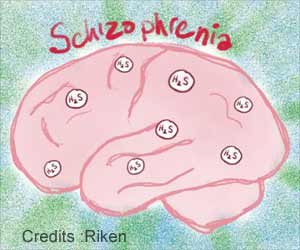Schizophrenia affects about 20 million people around the globe. Symptoms include hallucinations, delusions, flat affect (lack of emotional expression), loss of a sense of personal identity, and memory loss.
A new study led by researchers at the USC Dornsife College of Letters, Arts and Sciences and published in Nature Communications, centers on a protein called synapse-associated protein 97, or SAP97, that is found in neurons in the brain.
The normal function of SAP97 has remained elusive for many years. Not knowing how or where the protein works have also kept a veil over why mutations in SAP97 would lead to schizophrenia.
“Reduced SAP97 function may very well give rise to the largest increase in schizophrenia risk in humans that we know of, but the function of SAP97 has been a total mystery for decades,” said Bruce Herring, assistant professor of biological sciences at USC Dornsife.
SAP97 belongs to a family of proteins that regulate glutamatergic signaling between neurons and influence how memories are created and stored.
Glutamatergic signaling is an important way neurons communicate with each other that involves neurons releasing the neurotransmitter glutamate onto neighboring neurons.
Experiments up to now have failed to show that SAP97 plays any significant part in regulating glutamatergic signaling in the brain.
The lack of evidence for SAP97 function in regulating communication between neurons has frustrated scientists, given the growing evidence of the protein’s connection to schizophrenia.
With no SAP97 activity apparent in traditionally studied brain regions, researchers chose to look at a different region of the brain that has been theoretically linked to schizophrenia, called the dentate gyrus.
Studying rats with damaged SAP97, the researchers looked for changes in activity in the dentate gyrus and they found them. Neurons in the dentate gyrus with reduced SAP97 function showed extremely large increases in glutamatergic signaling.
The increase in signaling with mutated SAP97 suggests the protein normally helps dampen glutamatergic signaling specifically within the dentate gyrus.
The large increases in glutamatergic signaling in the dentate gyrus caused by reduced SAP97 function also produced significant deficits in contextual episodic memory in rodents a hallmark of schizophrenia.
The results are the first to confirm where in the brain SAP97 is active and to directly link alterations in dentate gyrus function to the development of schizophrenia.
In future studies, researchers plan to look for SAP97 activity in other areas of the brain. They will also determine whether schizophrenia-linked mutations in other proteins produce similar increases in glutamatergic signaling in the dentate gyrus.
Their ongoing work will significantly aid the development of more effective treatment strategies for this historically enigmatic disorder.
Source: Medindia



